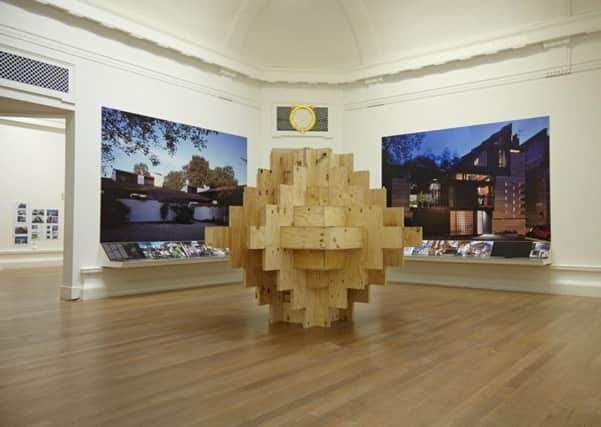Art review: RSA Annual Exhibition


The theme of home is always an attractive one and a great many of the homes here, either built or imagined, are very beautiful. Mostly they are in a recognisable international language of long, low rectangular masses, carefully integrated with the landscape, especially if they can be seen from afar. These features are epitomised in the houses built by Morris and Steadman from the late Fifties onwards, many in the environs of Edinburgh. Close-to, buildings in this style always have lots of glass to open them up to their immediate surroundings. A greenhouse and accompanying images by Dutch garden designer Piet Oudolf demonstrate this as a principle of design. It has taken a while, but the Morris Steadman houses and others like them demonstrate how modernism is now as mature and fluent a style as anything that went before it. If, however, looking at these beautiful mansions built in secluded places for private clients you wonder if architecture is simply an art for the rich, there are also alternatives here, a housing estate by Page and Park, for instance, and basic self-help housing in Africa by invited architects Orkidstudio. These latter make the point that, just as with the houses commissioned by the rich, the engagement of the clients in the process, even in this case in the actual construction, however humble they may be, changes fundamentally their relationship with the building. Perhaps it is this that transforms a building from a house to a home.
The architecture is displayed in diverse and ingenious ways – photographs, models, slide shows, light boxes and much else. One of the most striking objects is Anchorhold. A portable bothy that looks like a colourless Rubik’s Cube balanced on one corner, it was designed by Sutherland and Hussey in collaboration with Grizedale Arts for fishing on the ice. Very striking in this context, too, is Academy President Arthur Watson’s studio designed with architects Fergus Purdie and Patrick Fransen. It is a vertical block of undressed stone divided in the old Scots fashion into horizontal bands demarcated by narrow string courses. It is an arrangement much in contrast with the complex exterior of the house that architect Richard Murphy has built for himself in Edinburgh.
Advertisement
Hide AdAdvertisement
Hide AdIn various places, the rest of the annual exhibition merges with the architectural theme. A selection of works from the Academy’s collection has been brought in to reflect the relationship of painting and architecture. There are works by Frances Walker, for instance, that capture eloquently what a home actually looks like when it is a lived-in space. In one of his big diagrammatic works, Bruce McLean explores, mostly in words, childhood memories against the plan of his childhood home. There are also paintings of buildings in landscape by Gillies, Douglas Percy Bliss, Walter Geikie and others. This is perhaps not always an easy relationship, however. I amused myself by seeing how many of the elegant houses on display were adorned with art. Not many is the answer.
Generally though, the show does tend to fall into two parts, with the art relegated as so often the architecture has been to the two front rooms and the lower floor, although the theme of architecture does continue in austere paintings of industrial buildings by David Evans and in screen prints of glass-walled skyscrapers by John Mackechnie. A composition of two T-squares by Paul Furneaux is still an oblique reference to building, perhaps. More significantly, his abstract compositions of beautifully balanced rectangles are a little like the plans of the architects’ houses and so are a reminder of the common root that much contemporary art and architecture share in early modernist abstraction. Glen Onwin’s striking images of pure colour achieved by strange chemical reactions ultimately share the same formality, as do Doug Cocker’s beautiful cloud forms cut from sheets of wood.
One of the most ingenious works, also part performance, is by Derrick Guild. Referring back to 17th-century Dutch tulip mania, he is painting tulips, but also painting on tulips to try to recreate the rare and elusive flowers whose beauty drove that celebrated craze. David Mach’s Me and Mao, an extraordinary image of Marilyn Monroe metamorphosing into or out of an image of Mao, is quite surreal. Surrealism and architecture were never easy partners and here the two parts of this show really do part company, for Surrealism is the inspiration behind some of the best work here. It is the inspiration for John Byrne’s sinister world of malevolent teddy boys, for instance, even more for his striking self-portrait in which his cigarette and lighted match drift away from him as though endowed with a life of their own. Outstanding in the whole show, however, are four collages by Ian McCulloch, brilliantly coloured images of strange, metamorphic creatures. They acknowledge the surrealism of Miró and Picasso, but are a homage from an artist whose vision is quite his own. n
Until 25 May